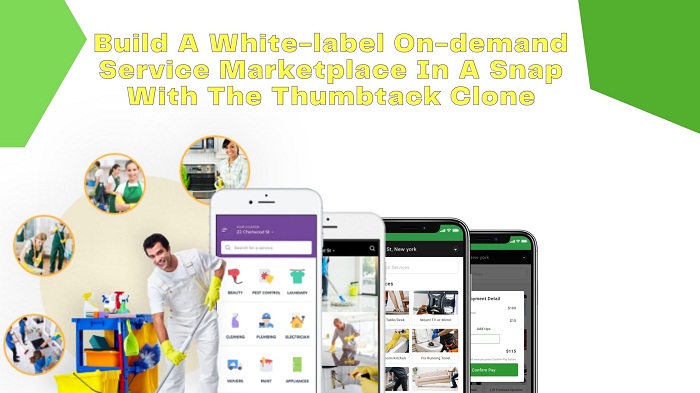APPS AND SOFTWARE
Everything You Need To Know About “Super Apps” And Why You Should Launch One

Hey there! Technology circles over providing wiser solutions that comfort our lives in various verticals. One such brainchild of technology is on-demand services apps. The term on-demand services have become the buzzword in recent times. While the whole world stranded in pandemic times, it was on-demand services that came as a savior. Without these on-demand services, availing of staples would become a question.
The increase in the adoption rate of on-demand services apps among users not only applies to the pandemic times but also the trend is about to continue in the upcoming years. Data given by Statista states that users are likely to depend on on-demand services even after the pandemic.
This change in the users’ behavior patterns obviously indicates that the need for on-demand services apps will also increase. Business owners who are trying to enter on-demand services, this is the right time to do so. In this blog, you will gain knowledge about launching super apps and the pioneers of super apps. See you there!
What Are Super Apps And Who Are The Pioneers?
Let us start with what super apps are. The name super apps are to personify apps that extend a number of on-demand services like taxi services, food delivery services, grocery delivery services, and a range of other services. The name, “super” best fits as users can avail of any number of services from a single app making it the king of every other app.
Apps like Gojek, WeChat, and Grab hold the name super apps as they provide multiple on-demand services from a single app. Gojek initially started out its business venture in ride-sharing services and then gradually expanded its verticals to provide other on-demand services. Gojek is one of the leading on-demand service providers beating its other competitors like WeChat and Grab.
WeChat is a popular multi-services on-demand app that was originally started with the intent of providing social media services but later took different perspectives by offering multiple services like e-payments, ride-hailing, ticket bookings, etc., WeChat has managed to acquire a large user base and retains them effectively.
Another multi-services giant is Grab. It is based out of South East Asia that ventured into the marketplace to provide ride-hailing services but later on spread out its verticals in other on-demand services like food delivery, e-commerce, grocery delivery, digital payments, etc.
When comparing Gojek with Grab, the former is preferred by users and driver-partners. Reasons like frequent discounts, nominal fare adds credit to the massive number of users. On the whole, if you are an investor, you can very well go ahead with developing the Gojek like on-demand apps. Let us start with the features of the app and move on to the other insights of developing the app.
Features of the Gojek like apps:
Onboarding– Users can sign up for the app either by completing the registration process or by using social media credentials.
Nearby Services– The app maintains a list of drivers who are located nearby users’ location. Users can view the drivers’ profiles and select the one who is closest to them.
Book Later– This feature is also called schedule booking, where users can book their rides or other services in advance.
Payment Options– Including a range of payment options will help in attracting more users worldwide. Popular and globally accepted payment gateways are PayPal, Stripe, Braintree, Amazon Pay, etc.,
GPS Enabled Route Assistance– Drivers can reach the user’s location by following the in-app route assistance.
Order Summary– Users can know every detail about their previous orders availed via the app under the order summary section.
Service History– Similar to how users can view their order history, the service provider can know their previous services processed via the app.
In-App Wallet– Through the in-app wallet users can pay for the services directly from the app without the need for making payments each time via the payment gateways.
Real-Time Order Tracing– While the app has every smart feature why not the tracking feature? Yes, the app has an in-built tracker that allows users to track the location of their services.
Call Masking– Contacting the driver or the user can be done via the app itself. Yes, the app’s call masking feature allows users/drivers to contact each other.
Admin Dashboard– Managing the entire app and other entities like users, drivers, and service providers can be done via the admin dashboard.
Toggle Mode– The admin can indicate the number of services offered at the moment via the toggle button. Based on this users will be able to choose the services.
All these features will add an enticing appeal to users while they avail of services via your app. As a next step, you will know the various levels of app development.
Level 1– The first level is planning your requirements. You will explain your business goals, your expectations, and other specifications of the app to your developer.
Level 2– The developer team will prepare a framework that is an overview of your requirements. The framework is also called a demo model. Based on the demo model provided by your developer, you can either input any suggestions or can approve directly.
Level 3– After you approve the demo model, the team will proceed with the customizations you insist on.
Level 4– The front-end development. Since this being a clone app development, developers will provide customization options for front-end development. You can choose the type of user interface you want and add customizations to make it more appealing.
Level 5 – As a final step, your app will be sent for testing. The app will undergo various levels of testing to ensure whether the app satisfies all your requirements.
Level 6– The launch phase! Your app is ready to deploy in Play Stores.
Conclusion
Wrapping up, get your Gojek clone script from an expert developer, and customize the app according to the market trend and target audience. All the best!
APPS AND SOFTWARE
Four Pillars to a Highly-Performing DevOps Strategy to Speed up Business Results

DevOps is a paradigm shift that bridges the gap between operations development instruments and the business to give an advantage to the business.
DevOps Technology is a disruptive force across all industries. The methods and products we utilized in the past do not fit in the framework of solutions for the future. Companies seek an improved, more efficient, and more efficient service delivery system to provide their customers with the best service.
The most important trend in recent times is the increasing use of Agile and DevOps methods. DevOps is intended to improve collaboration and coordination among the various departments of an organization to offer faster, better, and more reliable software solutions.
DevOps Mindset and Culture:
DevOps isn’t an additional software development technique. It’s a culture, an interplay of products, people, and processes, to create an organizational structure driven by performance. It’s not only for certain people or groups but all those involved in delivering value to customers.
To allow DevOps to ensure a productive, efficient, and seamless collaborative environment, all employees in the enterprise must adopt the culture and mindset of DevOps.
There are a variety of ways that can assist you in implementing a DevOps culture in your company.
- The teams (developers and Operations, QAs) work together. Every group has to be able to trust each another to ensure that quality code is delivered promptly.
- Recognize the concept within groups and work with them to develop imaginative solutions
- Don’t blame individuals; instead, make team members acknowledge the consequences of their mistakes.
- Set up a DevOps schedule in advance
- Instruct the team on the implications that are not adhering to the procedure
To ensure a successful transition to DevOps, massive business transformation projects must be undertaken, along with open communication across teams to ensure alignment. These DevOps techniques will enable companies to deliver more rapid, stable, consistent deliveries that can withstand changing market conditions. A DevOps engineer can provide your company with many quantifiable benefits by obtaining a DevOps Certification.
Adapting Microservices:
Companies have been using monolithic structures for quite a while now. Monolithic architecture is identical to a large container that houses all business functions tightly connected and arranged within a single.
Due to the tight packing of software programs into one unit, deploying services is challenging. The entire application must be reconfigured and rebuilt, even if a tiny software element requires an update. This results in high costs as well as lower agility and scalability.
However, over time companies recognized the importance of microservices over monolithic systems. The companies began looking at microservices to facilitate rapid and flexible delivery of software. Microservices architecture breaks up massive project software into small, autonomous modules that are then designed to perform specific tasks and communicate with one another via simple APIs.
Microservices introduced the idea of ‘fail quickly and repair faster. Microservices allow for parts of software that have problems can be corrected independently and deployed in a single, easy way without having to alter the application in its entirety. Smaller codebases can be managed by smaller teams, which results in greater efficiency, reliability, and scalability. Therefore, microservices can make a company more agile and flexible with its development efforts by increasing the speed and efficiency of execution.
The Quality Mindset that is Building
An organization must ensure synergy between speed and Quality to ensure the success of the business process.
Quality assurance in a DevOps organization isn’t limited to finding bugs but also stopping them from occurring in the beginning. A Software Development Life Cycle (SDLC) in DevOps culture requires speedy software development, continual testing, constant deployment, and constant monitoring. In this manner, manual testing must be eliminated, and automated testing needs to be implemented.
Automating the deployment process in a DevOps environment can result in quicker speed to market and better quality software solutions, and greater organizational efficiency.
DevOps practices speed up processes of software development using continuous Integration (CI) along with Continuous Delivery (CD), which allows businesses to work together and operate more efficiently.
Some other methods that are important to improve Quality include:
- In the process of establishing the Quality Improvement Plan based on feedback from customers and internal issues
- UI, API, and UT should be integrated into the Sprint development process so that automation is an integral element of delivery, which could cause an increase in technical debt.
- Resolve the technical debt in stages (first by removing the blockers, followed through code refactoring whenever feasible, and finally by resolving the most pressing issues)
- Create and develop high-quality gates (UT >90% and Code Complexity less than 15 and Code duplication less than 5%) and follow it
- Infuse code checks (SonarQube, PCLint, KlockWorks, Coverity, Fortify, etc.)
Tools and Automation
In a rush to launch their products early, everything in the development lifecycle (SDLC) is experiencing a paradigm shift. In the DevOps context, ensuring a continuous feedback system is essential. And with lots of data moving between different systems, the need to record everything becomes crucial.
So, integrating a system that allows collaboration across development testing, deployment and deployment will save you a significant amount of time that otherwise could require days to complete during DevOps implementation.
It is also crucial to choose the right tool because it must align with the same set of objectives for the business and ensure seamless integration and collaboration between tools.
Tools can record feedback and request. They can be connected to survey platforms and give feedback to customers, and social media platforms can provide team members with instant feedback. It will later assist in enhancing the product and identifying the team’s weaknesses, problems, and inefficiencies.
In a DevOps setting, using the appropriate tools for the right people isn’t sufficient. A proper connection to the DevOps tools is crucial to establish a cooperative working environment for the team.
Effective DevOps requires a symbiotic mix of tools, culture, and processes. These pillars can help organizations get a complete vision of building an effective DevOps strategy to help their business function quicker and lower risk in SDLC by utilizing automation or shorter development repetitions.
APPS AND SOFTWARE
5 Facts About the IoT Platform Market

Within the Internet of Things universe, an IoT platform is a multi-layer system that allows for easy provisioning, management and automation of connected devices. It essentially connects your gear, no matter how disparate, to the cloud via various connectivity options, enterprise-grade security measures and extensive data processing capabilities. Apart from this, it also provides a set of capabilities for developers that substantially accelerate the creation of connected device apps while also ensuring scalability and cross-device interoperability.
IoT platforms are essential for the creation of scalable IoT applications. The services of an IoT software development company will help you bridge the gap between the physical and virtual worlds between objects, systems and people.
Why Is an IoT Software Development Company Important for Your Business?
The Internet of Things (IoT) is a network of physical things, devices and other technology embedded in them with the goal to link and share data with other devices and systems via the Internet.
IoT devices monitor critical operations, provide new insights, increase efficiency and enable businesses to make better decisions through the collection and transmission of data. They give organisations insights on what is actually going on, not what they think or hope is going on. Since it is such an important piece of technology, an IoT software development company will help you to significantly transform your business.
Know The Different Types Of IoT Platforms:
IoT devices must incorporate several components from various tiers of the IoT technology stack. As a result, IoT devices are extremely complicated, making it nearly impossible to select a single platform capable of covering all aspects of the technology stack. That’s why, in order to cover the whole spectrum, you need various kinds of IoT platforms. The following are the most popular types of IoT platforms:
- Cloud platforms
- Platforms for IoT connectivity
- Platforms for IoT devices
- Platforms for data analytics
Selecting The Right IoT Platform:
While selecting the IoT platform, you should look for the following key areas –
- Reputation – Trusting or working with an unknown company for the core of your product might backfire. Therefore, evaluate the reputation and track record of the IoT software development company before choosing one.
- Open APIs – Extensibility will be crucial, so choose a supplier that allows you to access as much of their capabilities as feasible through programmatic means.
- Onboarding – It is not easy to switch to a new platform. Look for firms with a strong solutions department that can teach your team, assist with architecture and take you through the proof of concept stage.
IoT Platforms Market – Must-Know Facts:
- IoT platforms are designed to be generic because of which there will certainly be some gaps between their feature set and your ideal solution. The key here is to assess the size of the gap and determine whether or not you can bridge it.
- IoT platforms do, in fact, cost money. But, in the long run, these costs are insignificant when compared to the cost of building your own.
- Outsourcing non-core aspects of your product to an IoT platform can help you in reducing the risk, cutting the costs, improving the quality and shortening your time to market.
- Between 2015 and 2020, the IoT platform market grew to $800 million, resulting in a staggering 48 per cent CAGR.
Summing Up:
The complexity and dynamic nature of IoT systems is inevitable. They support a greater number of devices and evolve at a faster rate than traditional enterprise application software. The blend of AI (artificial intelligence) and ML (machine learning), which is a subset of AI, in IoT solutions helps simulate smart behaviour and helps in decision making with no or just a little human interference.
So if you are still not considering consulting an IoT software development company for AI & ML services, don’t be surprised if your competitors get first and offer more value-added services.
APPS AND SOFTWARE
Increase Your Business’ Growth With Window Blinds Software

Giving end clients the best window treatments requires a great deal of work, notwithstanding a decent comprehension of the current style and plan. Wholesalers are, in the present circumstance looking for software to assist them with meeting and surpass client assumptions. Furthermore, they see that awnings software enables their groups and supercharges development and benefits. So if you need to find out about this software and how its assists organizations with expanding their development.
Why Window Blinds Software Valuable For Wholesalers?
Before analyzing the elements of this product, we see for what reason to buy window blinds software. How it is valuable in a cutting-edge market, where the rivalry between window treatment organizations is savage. Wholesalers of blinds have been around for quite a long time and a considerable lot of them are dug in customary ways of working together. Significantly such software utilizes to deal with the entire of a blind distributer business and in addition to a piece of it.
- Better management of retailers: In the window treatment business, the emphasis is on treating retailers as clients and dealing with the orders that they place. While conveying these orders to retailers, wholesalers need to guarantee that the items meet the determinations laid out. This is the place where software is convenient as insights concerning orders like estimations, colors, texture, and more can be put away online by sale agents while they are working in the workplace or the field. With the guide of this information, completely flawless orders convey to retailers with practically no issues.
- Easily oversee clients and their information: Wholesalers and retailers in the window treatment industry need to look at details of a few hundred clients. Moreover, client information and insights concerning past orders need to access regularly and used to take new requests or convey items. BMS link software is helpful in this situation as it takes into consideration information to be accessed from any place in no time. Workers significantly don’t need to trust that pages will get done with stacking at a lethargic speed and get reliable day in and day out admittance to client information.
- Allows for simple access from any area: In case, you are investing time and energy into developing your business then there is a need for software that works without a hitch and problems. With the BMS interface, you get awnings software that can be effortlessly accessed through the web whether you are in the office, at home, or an extended get-away. The cloud-based software is accessed with the guide of a program, permitting you to make statements, take requests, and close deals from any area.
- Fast admittance to catalog and prices: Blinds wholesalers depend on lists with subtleties and pictures of items and costs in dominant sheets to make statements to retailers and to take orders. The software significantly lessens the requirement for getting sorted out and putting away paper-based indexes in file organizers. It additionally decreases the measure of physical work expected to look and discover them. Sales agents can, consequently, right away make statements inside a couple of snaps, send them to retailers and take orders dependent on them in practically no time. This quick course of making statements and taking requests permits wholesalers to beat contenders who are increasingly slow to win more deals.
- Operation costs are diminished definitely: Cash set aside is cash acquired, and at the BMS interface we comprehend this idea well. The product by removing physical work makes sure that independent ventures don’t need to recruit additional representatives in any event when they serve more clients. All things considered, existing staff can deal with more clients inside their work hours with the guide of software and the business can save money on pay rates.
- Business serves more clients easily: clients frequently require new window treatments while moving into another place, or when they need to redesign to deal with the blistering climate of summer. Wholesalers and retailers of blinds can deal with this unexpected expansion in client volume effectively in case they are utilizing the right software. Significantly, they don’t have to recruit impermanent staff, can, in any case, convey statements to clients before their rivals.
Organizations, for example, BMS interface, which offers window blinds software continue to add to highlights gave. If you want to buy window blinds software then, at that point, visit us today and get the most extreme advantages presented by this product. The features enlisted by such software, consequently, don’t stay stale however continue to increment. Reach us if you need to select a free preliminary and experience how BMS interface software functions.
-

 GAMING3 years ago
GAMING3 years ago5 Coolest Patterns In Mirror Cube That You Should Know
-

 Reviews2 years ago
Reviews2 years ago9xflix Com | 9xflix 2022 Bollywood Movies Download
-

 PC/TABLET/MOBILES4 years ago
PC/TABLET/MOBILES4 years agoPc Builder: Find The Best Parts For Your Pc And Your Workstation
-

 GAMING3 years ago
GAMING3 years ago11 Top Alternatives To Stream2watch For Live Streaming Sports
-

 TECH3 years ago
TECH3 years agoComplete Guide of 1337x Proxy 2021 | List of Unblocked 1337x Sites
-

 TECH3 years ago
TECH3 years agoWhat Are The Tricks To Resolve The Fritzbox 7590 Red Info Light?
-

 APPS AND SOFTWARE3 years ago
APPS AND SOFTWARE3 years agoBuild A White-Label On-Demand Service Marketplace In A Snap With The Thumbtack Clone
-

 PC/TABLET/MOBILES3 years ago
PC/TABLET/MOBILES3 years agoTop 7 Tech Products of the Decade That You Must Know















